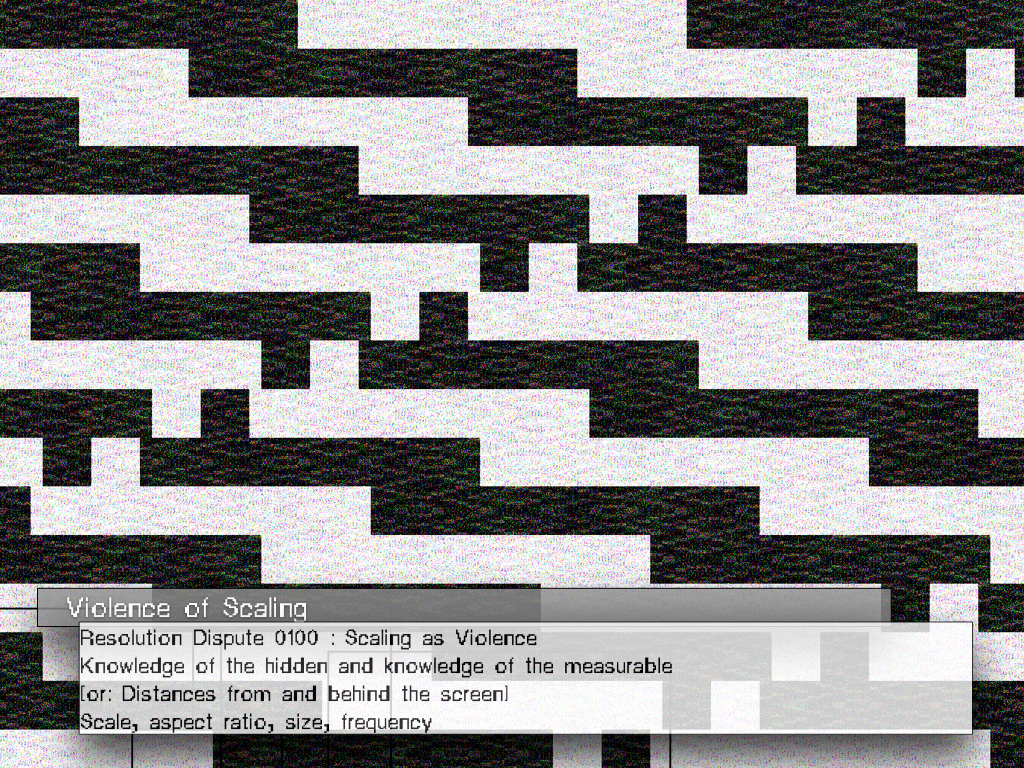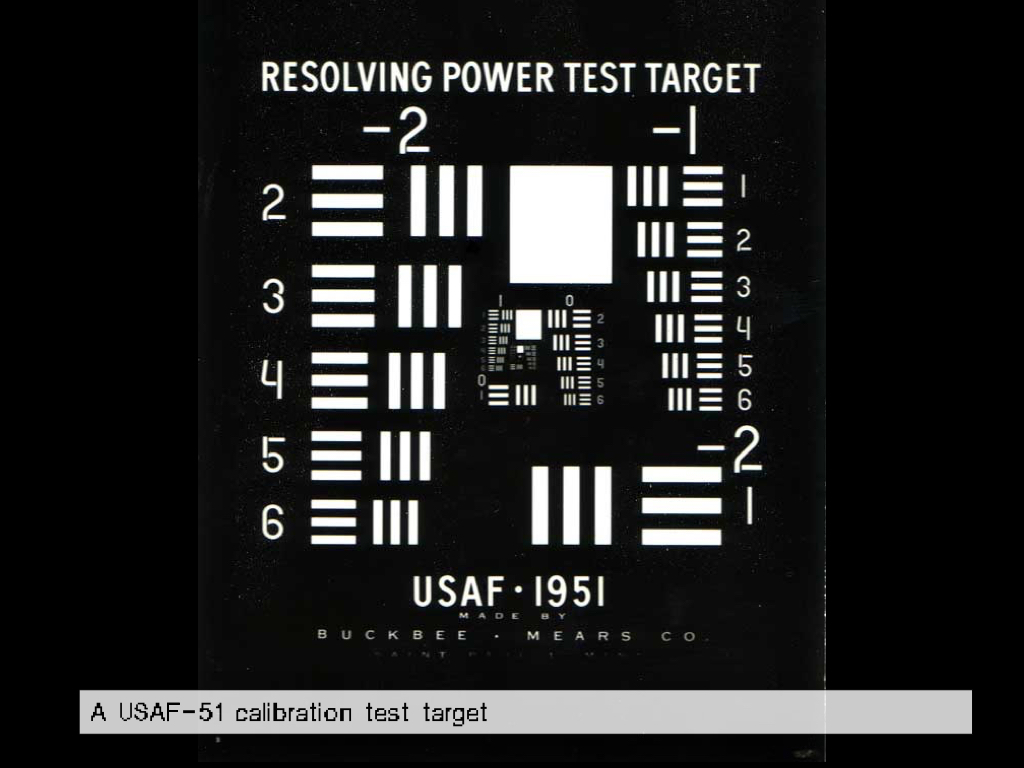SCALE: (as a tool of violence) // trade-offs at scale
ESSAY (THEORY)
>>> WHITEOUT (PDF) (2020)
VIDEO ESSAY (THEORY)
>> De/Calibration Target (2023)
>> WHITEOUT (PDF) (2019 - 2020)
ARTWORKS (PRACTICE)
>>> i.R.D. De/Calibration target (2023)
>>> Myopia (2015)
>>> WHITEOUT (2020)
>>> Lunar Storm (2013)
>>> Obsolute Gamuth at Zenith (2023)
[or: Distances from and behind the screen] Scale, aspect ratio, size, frequency.
What happens when something exist outside the dimensions or system units of scale?
In order to distinguish something of significance from its background environment we must first be able to perceive it.
If it remains invisible, inaudible, intangible, or unmeasurable it remains indiscribable and therefore unknowable at least to most of us.
- Graham Harman on OOO objects.

GEODETIC
SURVEY MARKER
OF THE
DE/CALIBRATION
TARGET
DCT REPO //
GENEALOGIES
◧⬒◨◧⬓
HOW NOT
TO BE READ.PDF
▣⬓⬒◨◧
DCT ENCRYPTION
STATION
◨◧◧⬓◨
JPEG
▣▣▣

IM/POSSIBLE IMAGES
◧⬒◨⬓◧
THE i.R.D.
DE/CALIBRATION
ARMY
◧⬒◨⬓◧
SHREDDED HOLOGRAM ROSE
◨◧◧⬓◨
The i.R.D. De/Calibration Target (2023)
“A blip, a glitch on a satellite photo, an error in the rendering of an image shot by a drone. What might seem a mistake is a freshly painted marker that sits on a rooftop in one of the most historic neighbourhoods of Berlin. Located at the riverside, near the remains of the Berlin wall, the target functions as an AR beacon. On activation offers access to a cache of research about JPEG compression.
This 16 x 16m target can only be read from above, reminding us that resolution, and its recognition, determines what is seen, unseen or illegible. In De/Calibration Target, Rosa Menkman explores what happens when something exists outside our dimensions or system units of scale, and asks what tools are needed to distinguish it from its environment.”
The i.R.D. de/calibration target (which spells FF D8 in DCT, the start of a JPEG image marker) is indexed and seen by satellites, to be distributed and visited online (for now just OSMAPS, Bing and Esri world imagery).
The marker makes an appearance in the Shredded Hologram Rose, when a media archeologist from the future visits the marker, which houses the DCT Repo - to find the information on how recalibrate == or de-glitch == the obsolete JPEG layer of a broken AI-Synthesized Hologram Rose.
======================
Commissioned for Out of Scale, the 2023 transmediale exhibition, the De/Calibration Target can only be seen from above through satellite imagery or taken home as a postcard souvenir of this aerial perspective from transmediale warehouse.
Produced by transmediale, with the support of the Stimuleringsfonds Creative Industries NL.

The De/Calibration Target is exhibited with a Geodetic Survey Marker.
An image of the De/Calibration Target is featured on the cover of Jussi Parikka’s There is Plenty of Room in the Simulation.

2015. Transfer Gallery, Brooklyn New York, US

Myopia (2015)
13x3.5m wall vinyl showcasing wavelets and extruding vectors.
Zooms into the JPG2000 wavelet compression artefacts.
Myopia zooms into the JPG2000 wavelet compression artefacts, created by introducing a line of ‘other language’ into the JPEG2000 file data.


Myopia at Size Matters. SIZE IN PHOTOGRAPHY.
February 1, 2024 – May 20, 2024,
KunstPalast, DE.

▋⌁
[analogue]
[analogue]
/ VERTICAL CINEMA :: LUNAR STORM
Commissioned by Sonic Acts and ESA (European Space Agency) as part of the Vertical Cinema program.
About the Vertical Cinema project
What we usually identify as the indisputable ‘temple of film’, the Cinema, is not really a given, especially not in the realm of experimental cinematic arts. Yet this is somehow sidelined in the process of re-thinking the possibilities of cinematic experience, mostly because the architectural frame is already there, if only as a convention established a long time ago within the theatrical arts. Actually, the history of experimental cinema and the art of the moving image suggests that the space might very well be the crucial aspect of the total audiovisual experience – something one should always question and take into consideration when producing a work for audiovisual, sensory cinema.
For the Vertical Cinema project we ‘abandoned’ traditional cinema formats, opting instead for cinematic experiments that are designed for projection in a tall, narrow space. It is not an invitation to leave cinemas – which have been radically transformed over the past decade according to the diktat of the commercial film market – but a provocation to expand the image onto a new axis. This project re-thinks the actual projection space and returns it to the filmmakers. It proposes a future for filmmaking rather than a pessimistic debate over the alleged death of film.
Vertical Cinema is a series of fourteen commissioned large-scale, site-specific works by internationally renowned experimental filmmakers and audiovisual artists, which will be presented on 35 mm celluloid and projected vertically with a custom-built projector in vertical cinemascope.
The programme is made solely for projection on a monumental vertical screen that was first upended in 2013 at Kontraste Festival in Krems, Austria.
About Lunar Storm. 4’15’’ COLOUR; 2013.
The surface of the Moon seems static. Though it orbits the Earth every 27.3 days, with areas of it becoming invisible during this rotation, it is always (visibly or invisibly) above us, reassuringly familiar. The Moon is the best known celestial body in the sky and the only one besides the Earth that humans have ever set foot on.
The Seas of the Moon (Lunar Maria), consisting not of water but of volcanic dust and impact craters, appear motionless to the naked eye. Here, volcanic dust forms a thick blanket of less reflec- tive, disintegrated micro particles. But on rare occasions, beyond the gorges of these Lunar Maria, and only when the lunar termi- nator passes (the division between the dark and the light side of the moon) a mysterious glow appears. This obscure phenomenon, also known as lunar horizon glow, is hardly ever seen from Earth.
Beyond the gorges of the Lunar Maria, the Moon is covered with lunar dust, a remnant of lunar rock. Pummelled by meteors and bombarded by interstellar, charged atomic particles, the molecules of these shattered rocks contain dangling bonds and unsatisfied electric connections. At dawn, when the first sunlight is about to illuminate the Moon, the energy inherent to solar ultraviolet and X-ray radiation bumps electrons out of the unstable lunar dust; the opposite process occurs at dusk (lunar sunset). These electrostatic changes cause lunar storms directly on the lunar terminator that levitate lunar dust into the otherwise static exosphere of the Moon and result in ‘glowing dust fountains’.
official website || Vertical Cinema about
Commissioned by Sonic Acts and ESA (European Space Agency) as part of the Vertical Cinema program.
About the Vertical Cinema project
What we usually identify as the indisputable ‘temple of film’, the Cinema, is not really a given, especially not in the realm of experimental cinematic arts. Yet this is somehow sidelined in the process of re-thinking the possibilities of cinematic experience, mostly because the architectural frame is already there, if only as a convention established a long time ago within the theatrical arts. Actually, the history of experimental cinema and the art of the moving image suggests that the space might very well be the crucial aspect of the total audiovisual experience – something one should always question and take into consideration when producing a work for audiovisual, sensory cinema.
For the Vertical Cinema project we ‘abandoned’ traditional cinema formats, opting instead for cinematic experiments that are designed for projection in a tall, narrow space. It is not an invitation to leave cinemas – which have been radically transformed over the past decade according to the diktat of the commercial film market – but a provocation to expand the image onto a new axis. This project re-thinks the actual projection space and returns it to the filmmakers. It proposes a future for filmmaking rather than a pessimistic debate over the alleged death of film.
Vertical Cinema is a series of fourteen commissioned large-scale, site-specific works by internationally renowned experimental filmmakers and audiovisual artists, which will be presented on 35 mm celluloid and projected vertically with a custom-built projector in vertical cinemascope.
The programme is made solely for projection on a monumental vertical screen that was first upended in 2013 at Kontraste Festival in Krems, Austria.
About Lunar Storm. 4’15’’ COLOUR; 2013.
The surface of the Moon seems static. Though it orbits the Earth every 27.3 days, with areas of it becoming invisible during this rotation, it is always (visibly or invisibly) above us, reassuringly familiar. The Moon is the best known celestial body in the sky and the only one besides the Earth that humans have ever set foot on.
The Seas of the Moon (Lunar Maria), consisting not of water but of volcanic dust and impact craters, appear motionless to the naked eye. Here, volcanic dust forms a thick blanket of less reflec- tive, disintegrated micro particles. But on rare occasions, beyond the gorges of these Lunar Maria, and only when the lunar termi- nator passes (the division between the dark and the light side of the moon) a mysterious glow appears. This obscure phenomenon, also known as lunar horizon glow, is hardly ever seen from Earth.
Beyond the gorges of the Lunar Maria, the Moon is covered with lunar dust, a remnant of lunar rock. Pummelled by meteors and bombarded by interstellar, charged atomic particles, the molecules of these shattered rocks contain dangling bonds and unsatisfied electric connections. At dawn, when the first sunlight is about to illuminate the Moon, the energy inherent to solar ultraviolet and X-ray radiation bumps electrons out of the unstable lunar dust; the opposite process occurs at dusk (lunar sunset). These electrostatic changes cause lunar storms directly on the lunar terminator that levitate lunar dust into the otherwise static exosphere of the Moon and result in ‘glowing dust fountains’.
official website || Vertical Cinema about






































 The day before the iRD closed its doors, visitors were invited to bring an Exacto Knife, to cut their own resolution of ‘Myopia’, and mount them on any institution of choice such as abook, computer or other rigid surface.
The day before the iRD closed its doors, visitors were invited to bring an Exacto Knife, to cut their own resolution of ‘Myopia’, and mount them on any institution of choice such as abook, computer or other rigid surface.